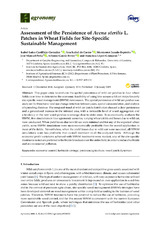Assessment of the Persistence of Avena sterilis L. Patches in Wheat Fields for Site-Specific Sustainable Management
Autor
Castillejo-González, I.L.
Castro, Ana Isabel de
Jurado-Expósito, M.
Peña, José Manuel
García-Ferrer Porras, Alfonso
López-Granados, Francisca
Editor
MDPIFecha
2019Materia
Economic controlHerbicide savings
Precision agriculture
Weed patch dynamics
METS:
Mostrar el registro METSPREMIS:
Mostrar el registro PREMISMetadatos
Mostrar el registro completo del ítemResumen
This paper aims to evaluate the spatial persistence of wild oat patches in four wheat fields over time to determine the economic feasibility of using late-season wild oat maps for early site-specific weed management (SSWM) next season. The spatial persistence of wild oat patches was analyzed by three tests: land use change detection between years, spatial autocorrelation, and análisis of spreading distance. The temporal trend of wild oat patch distribution showed a clear persistence and a generalized increase in the infested area, with a noticeable level of weed aggregation and a tendency in the new weed patches to emerge close to older ones. To economically evaluate the SSWM, five simulations in four agronomic scenarios, varying wheat yields and losses due to wild oat, were conducted. When yield losses due to wild oat were minimal and for any of the expected wheat yields, some SSWM simulations were more economically profitable than the overall application in most of the fields. Nevertheless, when the yield losses due to wild oat were maximal, all SSWM simulations were less profitable than overall treatment in all the analyzed fields. Although the economic profit variations achieved with SSWM treatments were modest, any of the site-specific treatments tested are preferred to herbicide broadcast over the entire field, in order to reduce herbicide and environmental pollution.

